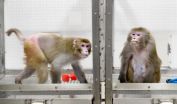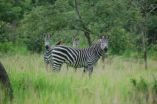(Press-News.org) The amount of water present in the moon may have been overestimated by scientists studying the mineral apatite, says a team of researchers led by Jeremy Boyce of the UCLA Department of Earth, Planetary and Space Sciences.
Boyce and his colleagues created a computer model to accurately predict how apatite would have crystallized from cooling bodies of lunar magma early in the moon's history. Their simulations revealed that the unusually hydrogen-rich apatite crystals observed in many lunar rock samples may not have formed within a water-rich environment, as was originally expected.
This discovery has overturned the long-held assumption that the hydrogen in apatite is a good indicator of overall lunar water content.
"The mineral apatite is the most widely used method for estimating the amount of water in lunar rocks, but it cannot be trusted," said Boyce, who is an adjunct assistant professor in the UCLA College of Letters and Science. "Our new results show that there is not as much water in lunar magma as apatite would have us believe."
The research was published online March 20 in the journal Science on and will be published in a future print edition.
For decades, scientists believed the moon was almost entirely devoid of water. However, the discovery of hydrogen-rich apatite within lunar rocks in 2010 seemed to hint at a more watery past. Scientists originally assumed that information obtained from a small sample of apatite could predict the original water content of a large body of magma, or even the entire moon, but Boyce's study indicates that apatite may, in fact, be deceptive.
Boyce believes the high water content within lunar apatite results from a quirk in the crystallization process rather than a water-rich lunar environment. When water is present as molten rock cools, apatite can form by incorporating hydrogen atoms into its crystal structure. However, hydrogen will be included in the newly crystallizing mineral only if apatite's preferred building blocks, fluorine and chlorine, have been mostly exhausted.
"Early-forming apatite is so fluorine-rich that it vacuums all the fluorine out of the magma, followed by chlorine," Boyce said. "Apatite that forms later doesn't see any fluorine or chlorine and becomes hydrogen-rich because it has no choice."
Therefore, when fluorine and chlorine become depleted, a cooling body of magma will shift from forming hydrogen-poor apatite to forming hydrogen-rich apatite, with the latter not accurately reflecting the original water content in the magma.
Understanding the story of lunar apatite has implications beyond determining how much water is locked inside lunar rocks and soil. According to the predominant theory of how the moon originally formed, hydrogen and other volatile elements should not be present at all in lunar rocks.
Many scientists theorize that the moon formed when a giant impact tore free a large chunk of Earth more than 4 billion years ago. If this "giant impact" model is correct, the moon would have been completely molten, and lighter elements such as hydrogen should have bubbled to the surface and escaped into space. Since hydrogen is a key component of water, a moon formed by a giant impact should be dry.
The majority of lunar samples are in fact very dry and missing lighter elements. Yet hydrogen-rich apatite crystals are found in a whole host of lunar samples and have presented a paradox for scientists. Somehow, despite the moon's fiery beginning, some water and other volatiles may have remained, though perhaps not as much as apatite initially implied.
"We had 40 years of believing in a dry moon, and now we have some evidence that the old dry model of the moon wasn't perfect," Boyce said. "However, we need to be cautious and look carefully at each piece of evidence before we decide that rocks on the moon are as wet as those on Earth."
This study shows that scientists still have much to learn about the composition and environment of the early moon.
"We're knocking out one of the most important pillars of evidence regarding the conditions of the formation and evolution of the moon," Boyce said. "Next, we plan to determine how badly apatite has distorted our view of the moon and how we can best see past it to get at the moon's origin."
INFORMATION:
The research was supported by a NASA Cosmochemistry grant and a NASA Lunar Advanced Science for Exploration Research grant.
Co-authors of the study include undergraduate Steven Tomlinson from UCLA, assistant research professor Francis McCubbin from the University of New Mexico, professor James Greenwood from Wesleyan University and staff scientist Allan Treiman from the NASA-funded Lunar and Planetary Institute.
Misleading mineral may have resulted in overestimate of water in moon
2014-04-01
ELSE PRESS RELEASES FROM THIS DATE:
Monkey caloric restriction study shows big benefit; contradicts earlier study
2014-04-01
MADISON, Wis. – The latest results from a 25-year study of diet and aging in monkeys shows a significant reduction in mortality and in age-associated diseases among those with calorie-restricted diets. The study, begun at the University of Wisconsin-Madison in 1989, is one of two ongoing, long-term U.S. efforts to examine the effects of a reduced-calorie diet on nonhuman primates.
The study of 76 rhesus monkeys, reported Monday in Nature Communications, was performed at the Wisconsin National Primate Research Center in Madison. When they were 7 to 14 years of age, the ...
Wind energy: On the grid, off the checkerboard
2014-04-01
WASHINGTON D.C., April 1, 2014 -- As wind farms grow in importance across the globe as sources of clean, renewable energy, one key consideration in their construction is their physical design -- spacing and orienting individual turbines to maximize their efficiency and minimize any "wake effects," where the swooping blades of one reduces the energy in the wind available for the following turbine.
Optimally spacing turbines allows them to capture more wind, produce more power and increase revenue for the farm. Knowing this, designers in the industry typically apply simple ...
Scientists solve the riddle of zebras' stripes
2014-04-01
Why zebras have black and white stripes is a question that has intrigued scientists and spectators for centuries. A research team led by the University of California, Davis, has now examined this riddle systematically. Their answer is published April 1 in the online journal Nature Communications.
The scientists found that biting flies, including horseflies and tsetse flies, are the evolutionary driver for zebra's stripes. Experimental work had previously shown that such flies tend to avoid black-and-white striped surfaces, but many other hypotheses for zebra stripes have ...
Should family businesses always keep it in the family?
2014-04-01
Montreal, April 1, 2014 – From the Murdochs to the Hiltons, families have long sought to keep their businesses in the bloodline. But new research from Concordia University's John Molson School of Business shows that's not necessarily the best method of management.
The recent study, published in the journal Entrepreneurship Theory and Practice, shows that if the family business is part of a traditional industry built on quality and reputation, a family member would make a good CEO. But if it operates in an industry that values innovation, and the firm has to stay on the ...
The human 'hairless' gene identified: One form of baldness explained
2014-04-01
It's not a hair-brained idea: A new research report appearing in the April 2014 issue of The FASEB Journal explains why people with a rare balding condition called "atrichia with papular lesions" lose their hair, and it identifies a strategy for reversing this hair loss. Specifically the report shows for the first time that the "human hairless gene" imparts an essential role in hair biology by regulating a subset of other hair genes. This newly discovered molecular function likely explains why mutations in the hairless gene contribute to the pathogenesis of atrichia with ...
Breast milk and diet up to 2 years old: A means of preventing the risk of child obesity
2014-04-01
This news release is available in French. Many studies have focused on the influence of breast-feeding on child health. From analysis of data from the ELANCE cohort, Marie Françoise Rolland-Cachera, former researcher at Inserm and her co-workers in the Nutritional Epidemiology Research Team (EREN) have shown that breast-feeding has a protective effect on the risk of obesity at 20 years of age. Researchers also emphasise that nutritional intake at the age of 2 years are critical in providing this beneficial effect. The results of the study are published in The Journal ...
One currency, one price?
2014-04-01
Economics has a "law of one price," which states that identical goods should, in theory, sell for identical prices — or else markets will even out the differences. Empirical work on the topic, however, has produced little evidence in support of this "law," and many studies showing deviations from it.
Now a newly published paper co-authored by two MIT economists, along with a colleague from the University of Chicago, presents evidence of a strong convergence of prices within the Eurozone, the region of European countries sharing a common currency. The divergence of product ...
First evidence that very small embryonic-like stem cells
2014-04-01
New Rochelle, NY, April 1, 2014 -- Rare, very small embryonic-like stem cells (VSELs) isolated from human adult tissues could provide a new source for developing regenerative therapies to repair complex tissues damaged by disease or trauma. The ability of these most-primitive, multipotent stem cells to differentiate into bone, neurons, connective tissue, and other cell types, and the proper criteria for identifying and isolating VSELs, are described in two articles in Stem Cells and Development, a peer-reviewed journal from Mary Ann Liebert, Inc., publishers. The articles ...
Survey shows spine surgeons need to screen more patients for anxiety and depression
2014-04-01
In a report published in the April edition of the Journal of Spinal Disorders and Techniques, a Johns Hopkins team says that only 10 percent of orthopaedic surgeons and neurosurgeons follow professional guidelines recommending routine psychological screenings of patients prior to major surgery for severe back and leg pain.
The oversight, researchers say, may pose a serious risk to patients' surgical recovery. Previous reports have tied bouts of depression to longer recuperations, delayed returns to work, more postsurgical complications and failures to comply with medication ...
Overcoming structural uncertainty in computer models
2014-04-01
Philadelphia, PA--A computer model is a representation of the functional relationship between one set of parameters, which forms the model input, and a corresponding set of target parameters, which forms the model output. A true model for a particular problem can rarely be defined with certainty. The most we can do to mitigate error is to quantify the uncertainty in the model.
In a recent paper published in the SIAM/ASA Journal on Uncertainty Quantification, authors Mark Strong and Jeremy Oakley offer a method to incorporate judgments into a model about structural uncertainty ...




